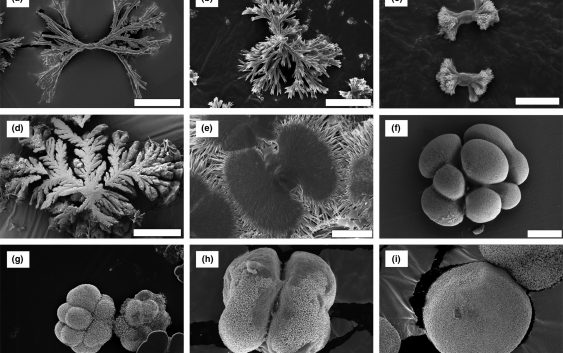Rouillard, J.; Garcia-Ruiz, J. M.; Gong, J.; van Zuilen, M. A., A morphogram for silica-witherite biomorphs and its application to microfossil identification in the early earth rock record. Geobiology 2018.
Archean hydrothermal environments formed a likely site for the origin and early evolution of life. These are also the settings, however, were complex abiologic structures can form. Low-temperature serpentinization of ultramafic crust can generate alkaline, silica-saturated fluids in which carbonate-silica crystalline aggregates with life-like morphologies can self-assemble. These “biomorphs” could have adsorbed hydrocarbons from Fischer-Tropsch type synthesis processes, leading to metamorphosed structures that resemble carbonaceous microfossils. Although this abiogenic process has been extensively cited in the literature and has generated important controversy, so far only one specific biomorph type with a filamentous shape has been discussed for the interpretation of Archean microfossils. It is therefore critical to precisely determine the full distribution in morphology and size of these biomorphs, and to study the range of plausible geochemical conditions under which these microstructures can form. Here, a set of witherite-silica biomorph synthesis experiments in silica-saturated solutions is presented, for a range of pH values (from 9 to 11.5) and barium ion concentrations (from 0.6 to 40mmol/L BaCl2 ). Under these varying conditions, a wide range of life-like structures is found, from fractal dendrites to complex shapes with continuous curvature. The size, spatial concentration, and morphology of the biomorphs are strongly controlled by environmental parameters, among which pH is the most important. This potentially limits the diversity of environments in which the growth of biomorphs could have occurred on Early Earth. Given the variety of the observed biomorph morphologies, our results show that the morphology of an individual microstructure is a poor criterion for biogenicity. However, biomorphs may be distinguished from actual populations of cellular microfossils by their wide, unimodal size distribution. Biomorphs grown by diffusion in silica gel can be differentiated by their continuous gradient in size, spatial density, and morphology along the direction of diffusion.


